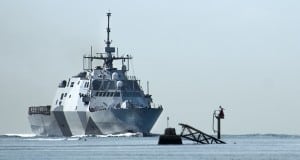
Defense Secretary Chuck Hagel announced Monday he was reducing the Navy’s controversial Littoral Combat Ship program by 20 vessels, questioning whether the ship can adequately defend itself, and said he was instructing the service to examine more suitable alternatives for future small surface combatants. Hagel, previewing the Pentagon’s budget proposal for fiscal 2015 ahead of next week’s release to Congress, told reporters he determined the Navy was overly reliant on the program to reach its planned goal of a 300-ship…













